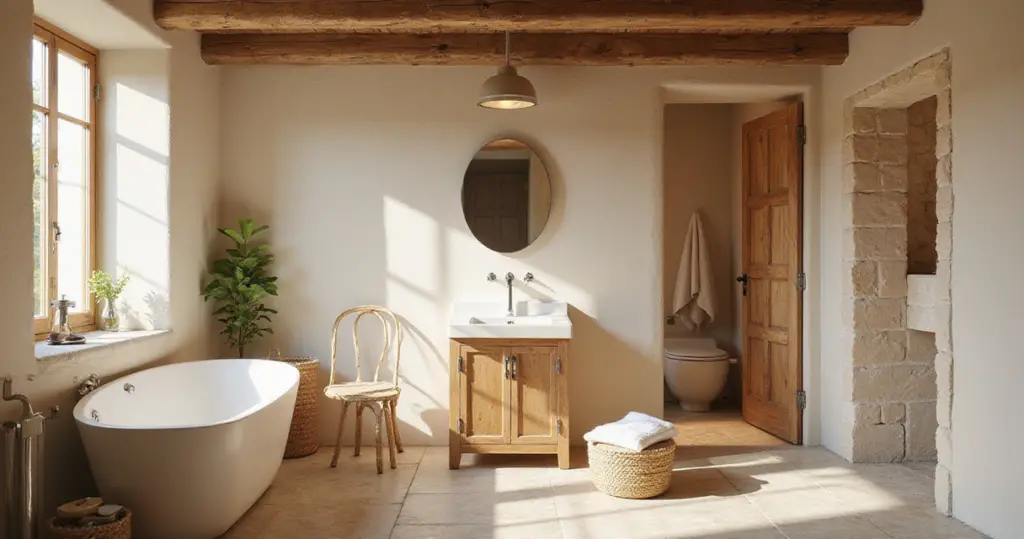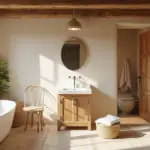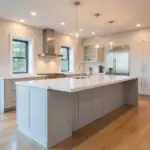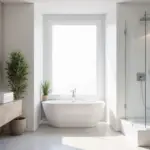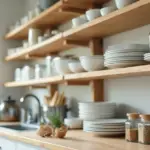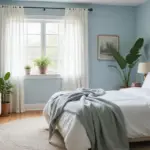Can we talk about why everyone gets “rustic” decor wrong?
People see a few raw beams and a sliding barn door and think they’ve captured it. They slap some shiplap on a wall and call it a day. But that’s not rustic; it’s a costume. A real rustic space isn’t a theme you apply—it’s a feeling you cultivate. It’s a response to the landscape around you, whether that’s a sprawling desert or a dense forest.
My design philosophy is rooted in two places that deeply understand this: the sun-drenched courtyards of the Middle East and the light-filled, functional homes of Scandinavia. Both cultures learned to build with what they had, to respect the climate, and to find beauty in simplicity and honest materials. True rustic design, for me, is found at that intersection. It’s about the soul of a space—the warmth in its minimalism, the story in its textures, and the intelligence in its design. It’s not about recreating a farmhouse. It’s about creating a sanctuary that feels timeless, grounded, and deeply, authentically yours.
Let’s cut through the noise. Here’s how you can create a rustic bathroom that actually feels right.
Establishing the Rustic Foundation
This is the most important part. If you get the bones wrong, no amount of charming accessories can save it. The foundation isn’t about decor; it’s about light, color, and intention. It’s the deep, quiet work that makes everything else fall into place.
1. Select a Palette Inspired by the Earth, Not a Paint Swatch
Everyone says to start with warm neutrals, and they’re not wrong. But don’t just grab a beige paint chip and call it a day. The real trick is to think about the quality of the light your bathroom receives and choose colors from the natural world that know how to handle it. In the harsh desert sun I often work with, a simple white can feel glaring and sterile. But a soft, plaster-like white, a tadelakt finish, or the color of pale sand—these have a depth that absorbs and softens intense light.
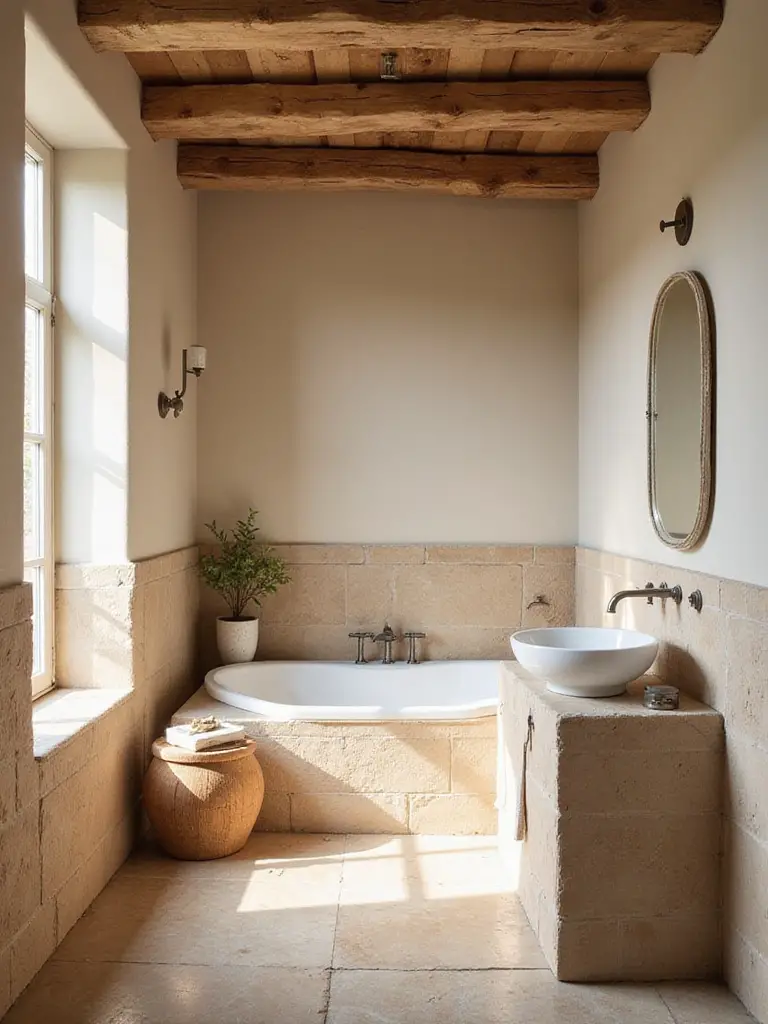
I learned this the hard way on an early project. I used a client’s “perfect greige” and watched it turn flat and lifeless under the afternoon sun. I had to repaint the entire room in a custom-mixed lime wash that had subtle variations in tone. It immediately gave the walls life and a soft, velvety texture that felt ancient and modern all at once. So think about the color of stone, clay, sun-bleached wood, and dry grasses. These are palettes that have been time-tested by nature. They provide a calm, sophisticated backdrop that makes your natural materials—the real stars—truly sing.
With the right colors on the walls, your next move is to think about the light that will wash over them.
2. Treat Natural Light as Your Most Valuable Material
You can have the most beautiful materials in the world, but without good light, they’re lifeless. This is a core principle in both Scandinavian design, with its huge windows to capture scarce winter sun, and Middle Eastern architecture, with its brilliant use of courtyards and screened openings (mashrabiya) to filter it. The goal isn’t just to have a window; it’s to manage and sculpt the light that comes through it.
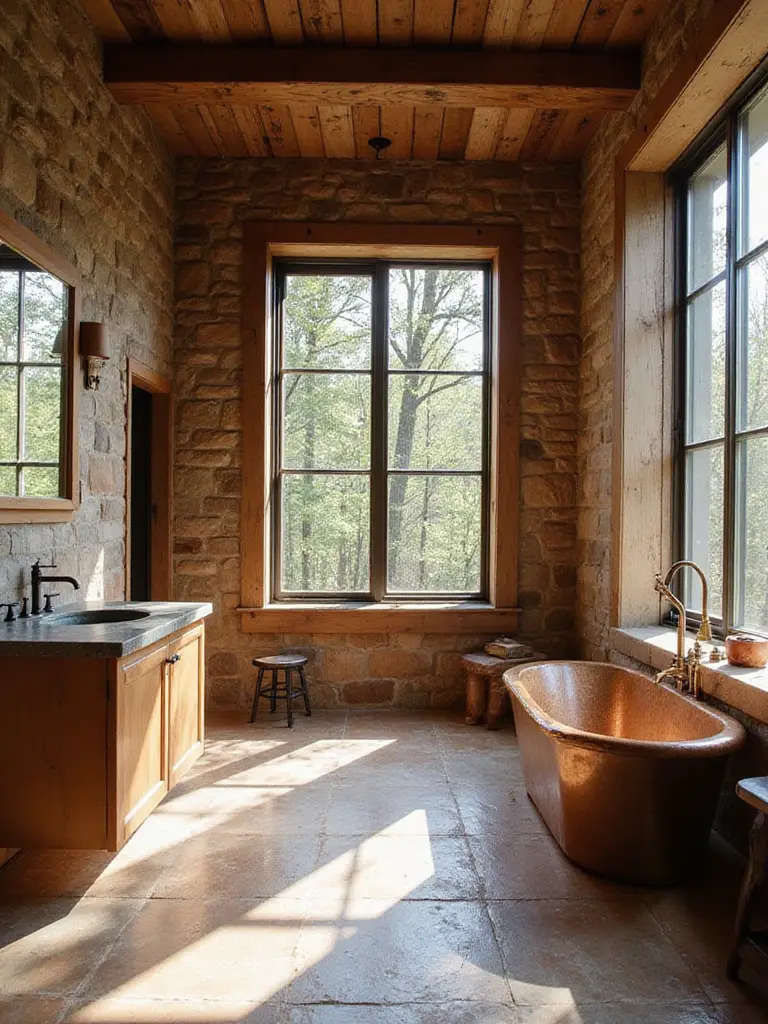
Don’t just default to a frosted glass window for privacy. Instead, consider a high clerestory window that lets in light without sacrificing privacy. Or use a light-filtering linen shade that softens the glare while adding beautiful texture. I once designed a desert bathroom where the only window faced a block wall. Instead of seeing it as a problem, we built a small, private courtyard outside with a single olive tree and white gravel. The light now bounces off the gravel and dapples through the leaves, projecting moving shadows onto the bathroom wall. It turned a bad view into a living work of art.
And remember, light’s best partner is a mirror. A large, simple mirror placed opposite a window can literally double your light, making a small space feel open and alive.
Once you’ve mastered the light, you need to define what your personal version of “rustic” truly is.
3. Define Your Philosophy, Not Just Your “Sub-Style”
The internet will tell you to pick between “farmhouse,” “lodge,” or “cabin.” I find this incredibly limiting. Those are labels, not a design compass. The real question is: What story do you want your space to tell? Is it about connecting to the surrounding woods? Then perhaps you lean towards the textures and tones of a cabin. Is it about finding calm and quiet in an urban environment? Then your version of rustic might be more about minimalist forms and natural, tactile materials.
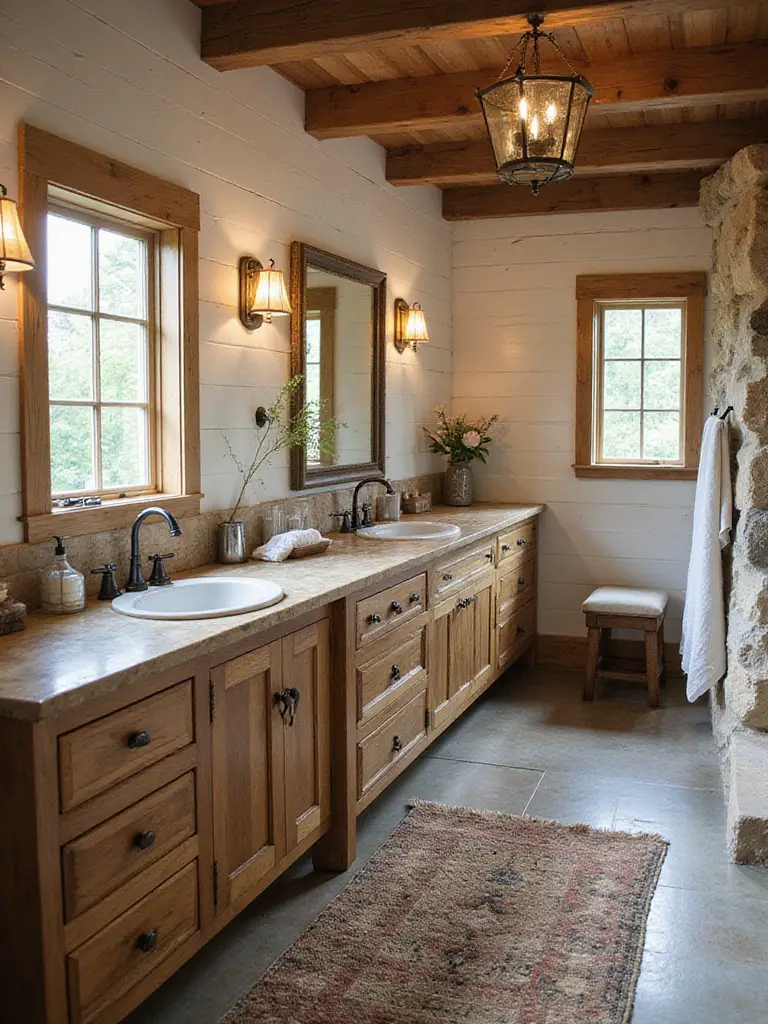
I encourage my clients to think in terms of principles. For me, it’s about a conversation between the clean, functional lines of Scandinavian minimalism and the warm, earthy textures of desert architecture. The result is a kind of warm minimalism. So, forget the labels. Ask yourself: “How do I want to feel in this space?” Grounded? Cozy? Serene? Energized? Your answer to that is your sub-style. That feeling will guide your choices far better than a label ever could.
With your guiding philosophy clear, it’s time to gather your thoughts into a tangible plan.
4. Create a Tactile Mood Board
A digital Pinterest board is great for initial inspiration, but rustic design is all about how things feel. The way light hits rough-hewn wood versus smooth stone, the coolness of a brass tap, the softness of a linen towel—these are the details that make the design come alive. That’s why I insist on making a physical mood board. Get actual samples. A small tile, a wood chip, a swatch of fabric, a piece of metal hardware, a paint card.
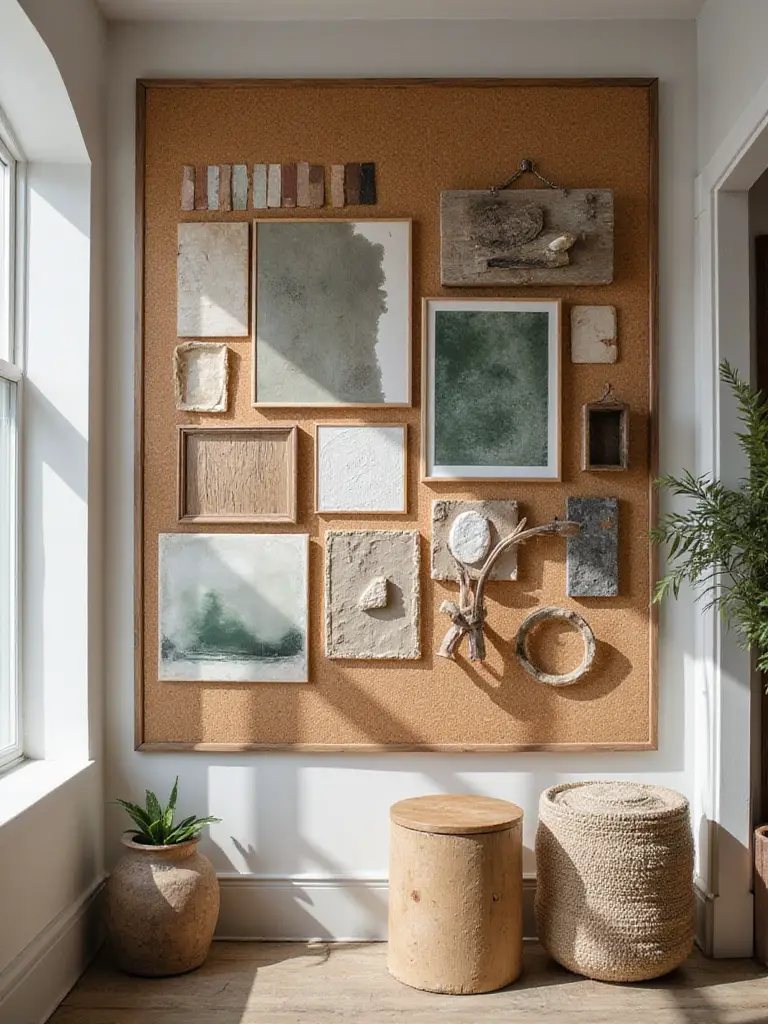
Arrange them together and live with them for a few days. See how they look in the morning light versus the evening. Touch them. You’ll be amazed at what you discover. You might find that the wood you loved online feels too polished in person, or that two textures you didn’t expect to work together create a beautiful harmony. This small step saves you from costly “it looked different online” mistakes and ensures the final result feels cohesive and deeply intentional.
This tangible plan ensures that as you move forward, your beautiful design is also perfectly livable.
5. Prioritize “Forever” Functionality
Both Scandinavian and Middle Eastern design traditions are, at their core, intensely practical. Things are beautiful because they are built to last and to work effortlessly. In a bathroom, this isn’t an afterthought—it’s everything. True rustic design feels lived-in and comfortable because it’s inherently functional. This means thinking about things like ventilation not just for code, but for protecting your beautiful wood and stone from moisture. It means planning for storage that hides the plastic bottles so the beautiful, honest materials can shine.
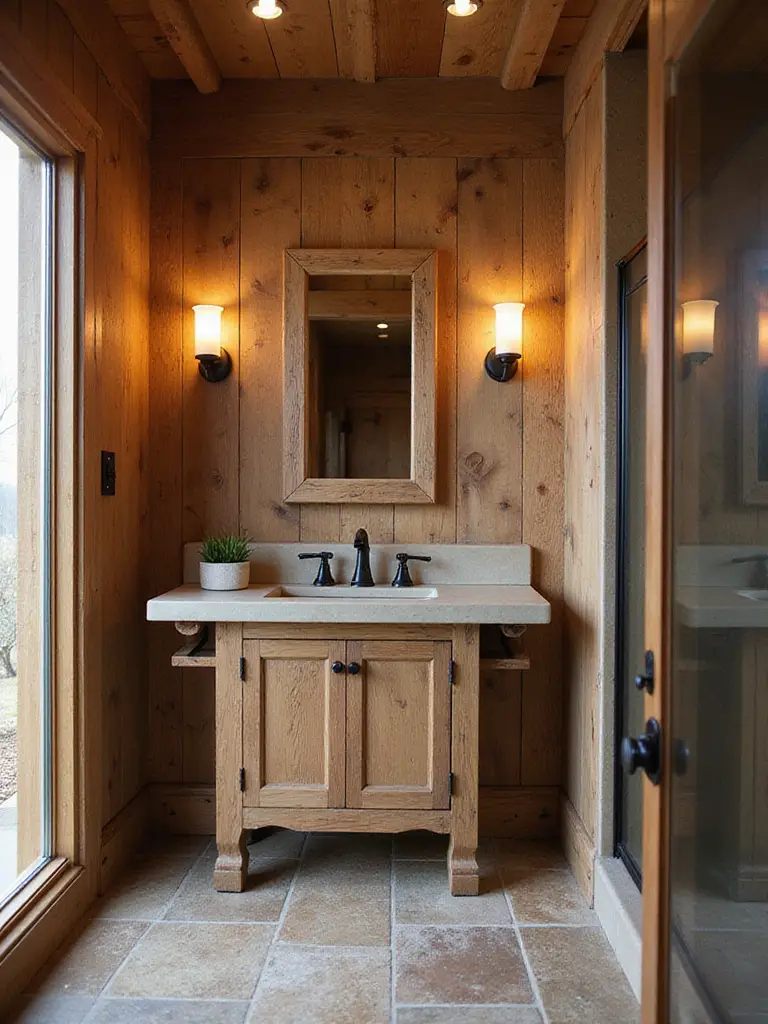
One shortcut I wish I’d known earlier is to think about ergonomics from the start. Where will you hang your wet towel so it dries properly? Is the vanity at a height that’s comfortable for you? Is the lighting positioned to eliminate shadows when you’re at the mirror? I often specify niches in shower walls—a detail borrowed from ancient hammams—because they provide seamless storage without cluttering the space with racks. By designing for comfort and practicality first, you create a space that you will love not just for how it looks, but for how it works for you, every single day.
Integrating Authentic Rustic Materials
Now for the fun part: the materials. This is where your space gets its soul. Don’t think of this as decorating. Think of it as composing with texture, history, and light.
6. Use Reclaimed Wood with Intention
Reclaimed wood is the poster child for rustic design, but using it effectively is about restraint. A whole wall of rough, dark barn wood can feel heavy and thematic, especially in a small bathroom. Instead, think of it as a precious resource. Use a single, beautiful beam overhead to draw the eye up. Install a thick, floating shelf of sun-bleached wood to hold a few beautiful objects. Or, my favorite, use it as a vanity countertop, sealed beautifully to withstand water but with its history of nail holes and saw marks still visible.
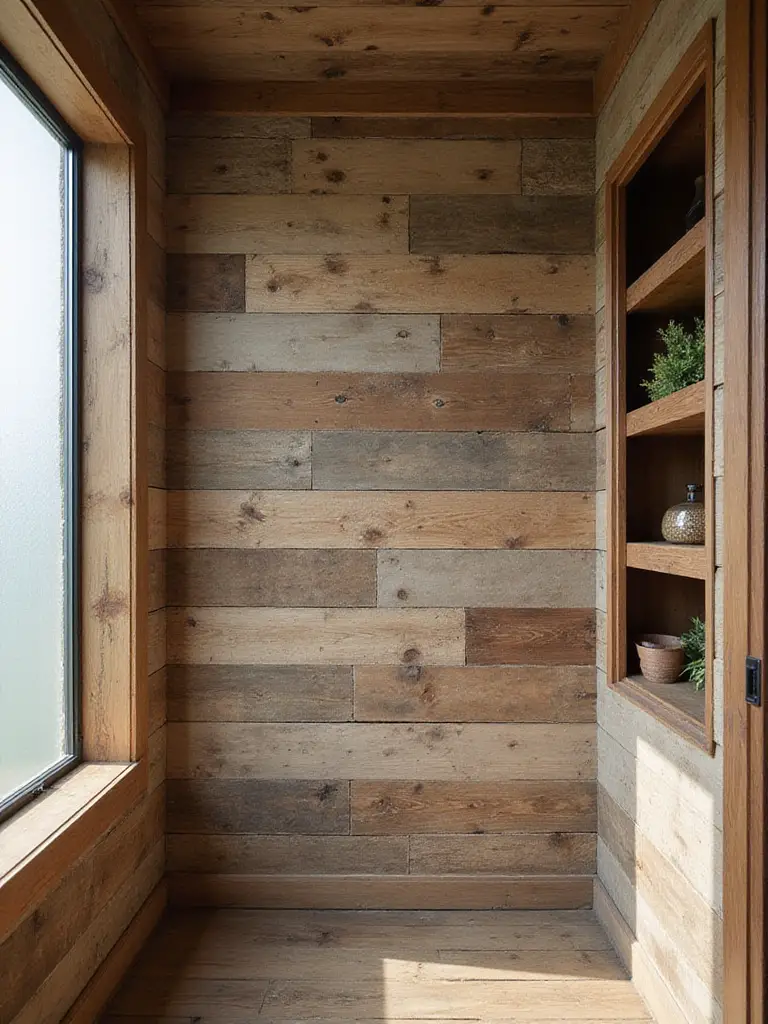
The point is to celebrate the wood’s individual character. Choose pieces that have a story. I once used wood salvaged from an old water tower to build a vanity for a home in a dry, desert climate—it was a subtle nod to the importance of water in the region. That’s what makes a space feel authentic. It’s not just old wood; it’s wood with a sense of place.
That wood will need a partner to ground it, which is where stone comes in.
7. Ground the Space with Stone
If wood brings warmth, stone brings a sense of permanence and connection to the earth. In a bathroom, this can be transformative. Think beyond just a stone countertop. A shower floor laid with smooth, flat river pebbles feels incredible underfoot and turns the act of showering into a sensory experience. A backsplash of textural, split-face slate or travertine catches the light in a thousand different ways throughout the day.
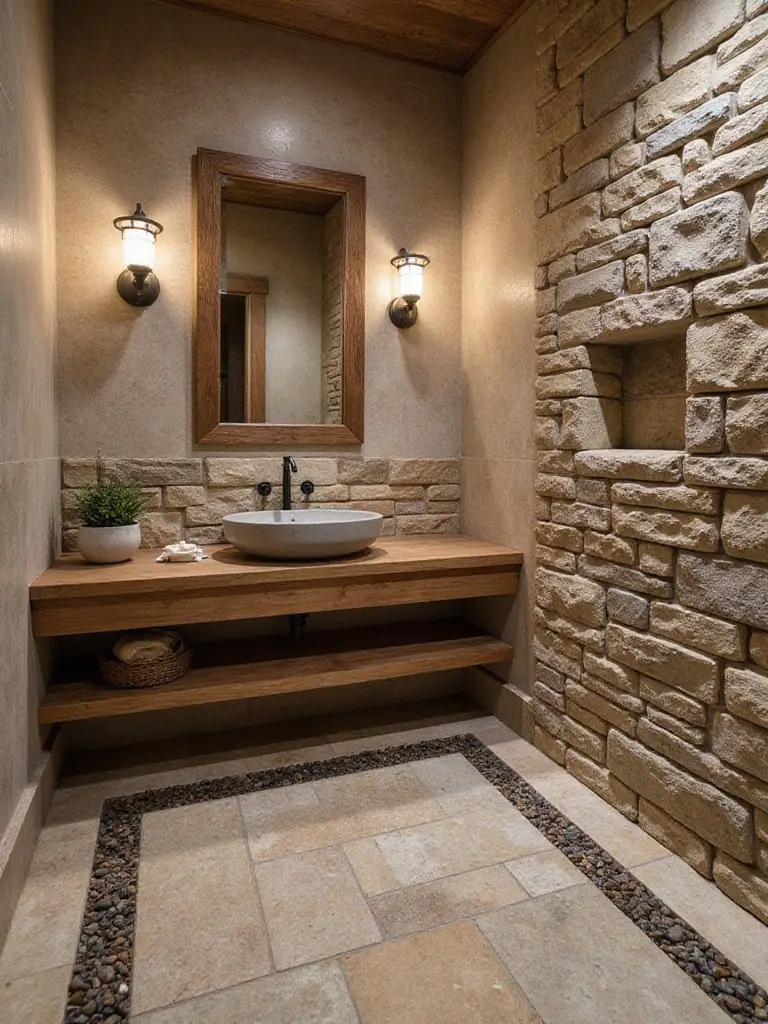
Just be sure to choose a stone that is appropriate for a wet environment and your climate. In hot climates, I avoid dark stones on floors as they can hold a lot of heat. Lighter stones like travertine or limestone feel cooler and more expansive. I once specified a solid block of limestone carved into a sink for a client. It was the only stone element in an otherwise wood and plaster bathroom, and its weight and presence anchored the entire room. It felt less like a fixture and more like a piece of the landscape brought indoors.
Now, let’s add the jewelry: the metalwork.
8. Choose Metals That Live and Breathe
The BS everyone believes is that rustic means oil-rubbed bronze everything. While that can work, a far more interesting approach is to use “living finishes”—metals that are unlacquered and designed to patina over time. Unlacquered brass is my absolute favorite. When new, it’s bright and warm. Over years of use, it will darken and develop a unique pattern based on how you touch it. It tells the story of your daily rituals.
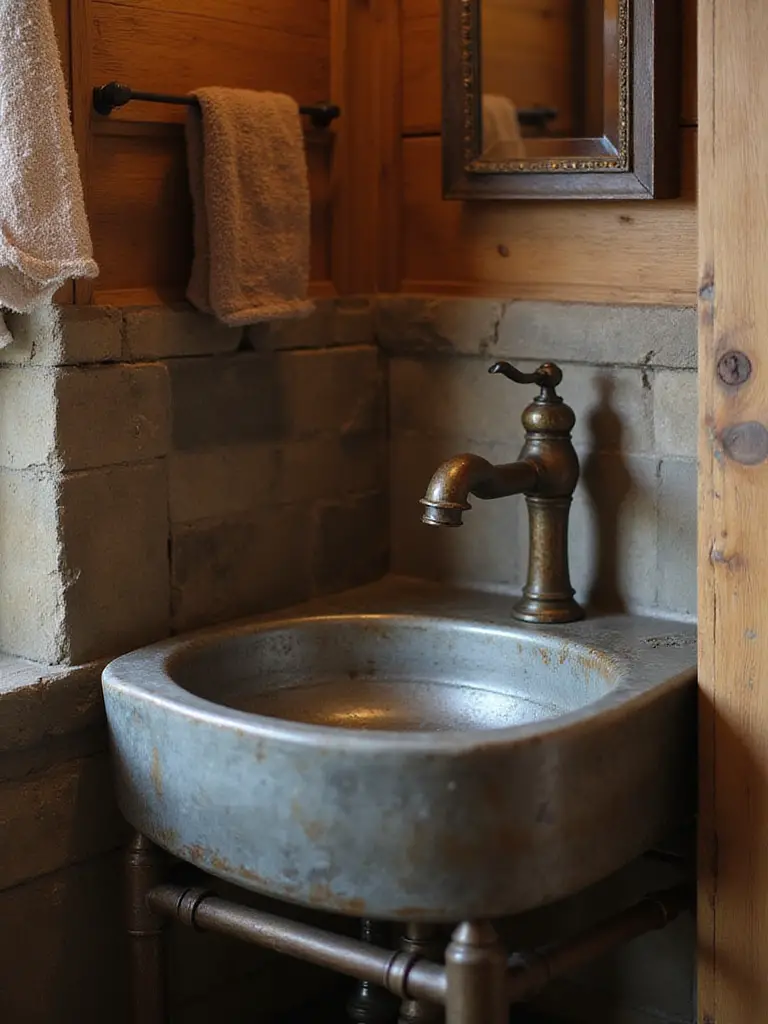
Matte black is another fantastic option, especially if you’re leaning into a more modern, minimalist rustic feel. It provides a crisp, graphic contrast to the softness of wood and stone without the distracting shine of chrome. The key is to avoid anything that feels too perfect or plastic-coated. You want your metal fixtures to feel substantial, honest, and as if they will age gracefully right alongside the other natural materials in the room.
Another material that speaks of history and substance is brick.
9. Use Exposed Brick, but Wisely
There’s nothing like an exposed brick wall to add instant texture and history. It just feels solid and real. But here’s the shortcut I wish everyone knew: it’s not always a good idea, especially on a wall that faces the sun in a warm climate. Brick is a thermal mass, meaning it absorbs, stores, and radiates heat. An exterior brick wall can bake your bathroom all afternoon.
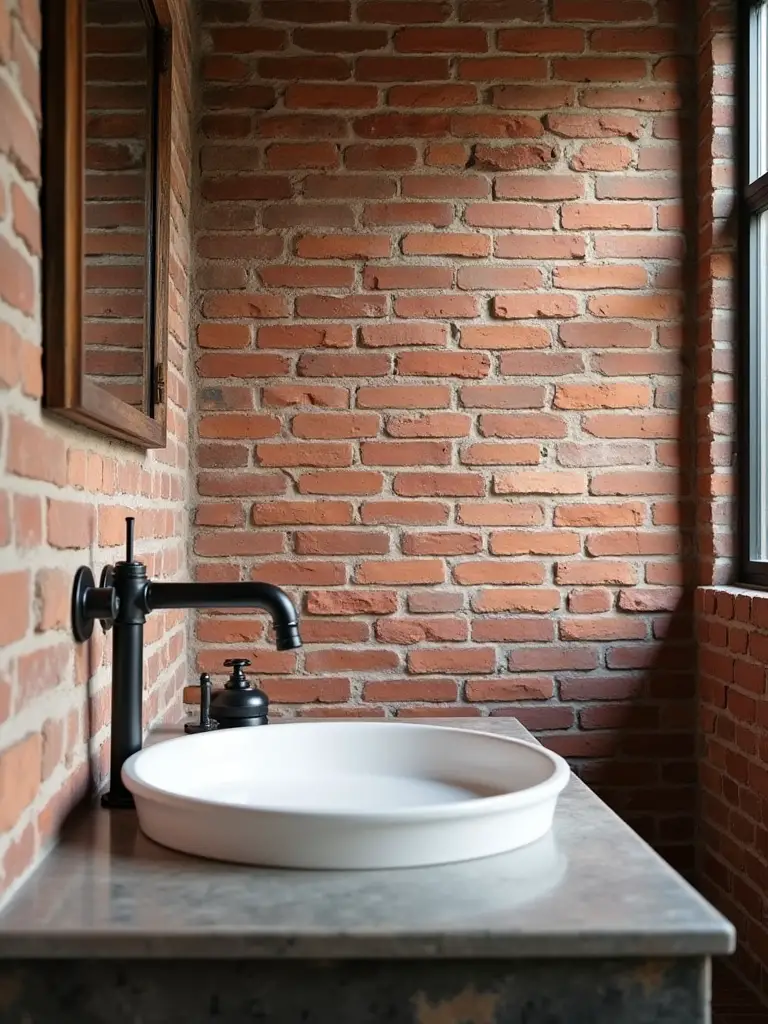
Instead, use it on an interior wall as a feature. Or, for a similar textural effect without the thermal drawback, consider Zellige tiles. These are handmade glazed clay tiles from Morocco, where each one is slightly different in shape and color. They have the same rustic, imperfect quality as brick but with a beautiful, light-reflecting sheen that feels perfectly suited to a bathroom. I used a wall of white zellige tiles in a recent project, and the way it shimmered in the light gave the room a sense of life and movement that a flat wall never could.
To complement this texture, let’s consider a classic metal choice, reimagined.
10. Reinterpret Wrought Iron with Clean Lines
When people hear “wrought iron,” they often picture heavy, scrolled, country-style fixtures. For a more refined and modern rustic look, think about iron in a different way. Think of the simple, strong, and slender lines of Scandinavian metalwork or the geometric patterns of Middle Eastern screens. Look for a mirror with a very thin, minimalist matte black frame. Or a light fixture with a simple, elegant arm.
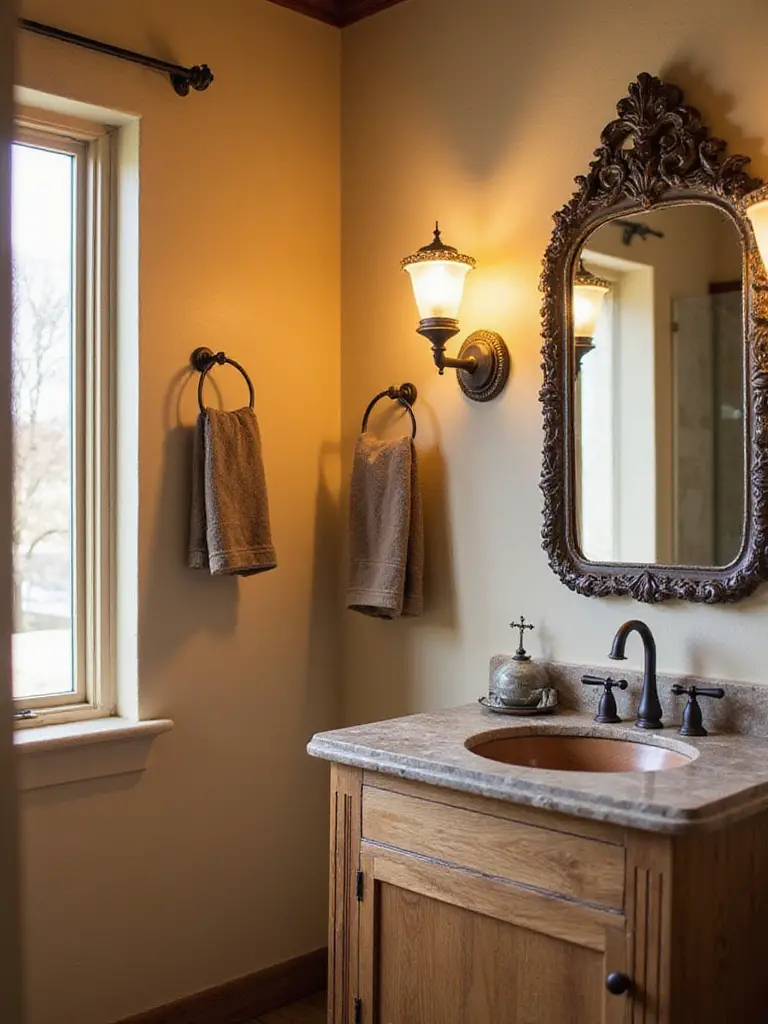
One of my favorite ways to use this is in custom work. I once designed a vanity with a simple, light-colored wood base and commissioned slender, black iron legs. It elevated the piece, making it feel lighter and more like a piece of fine furniture, while still providing that strong, grounding element of a dark metal. The focus should be on the material’s strength and simple beauty, not on decorative flourishes.
Now, let’s soften all these hard surfaces with some essential textures.
11. Layer with Natural Fibers for Warmth and Softness
A room full of wood, stone, and metal can feel cold, no matter how beautiful it is. The finishing touch that makes a space feel like a sanctuary is the addition of soft, natural fibers. This is non-negotiable. It’s the textural contrast that creates true comfort and a “hygge” sense of well-being. Think of a thick, woven cotton or wool bath mat that feels wonderful underfoot. Or simple, elegant linen towels that are incredibly absorbent and get softer with every wash.
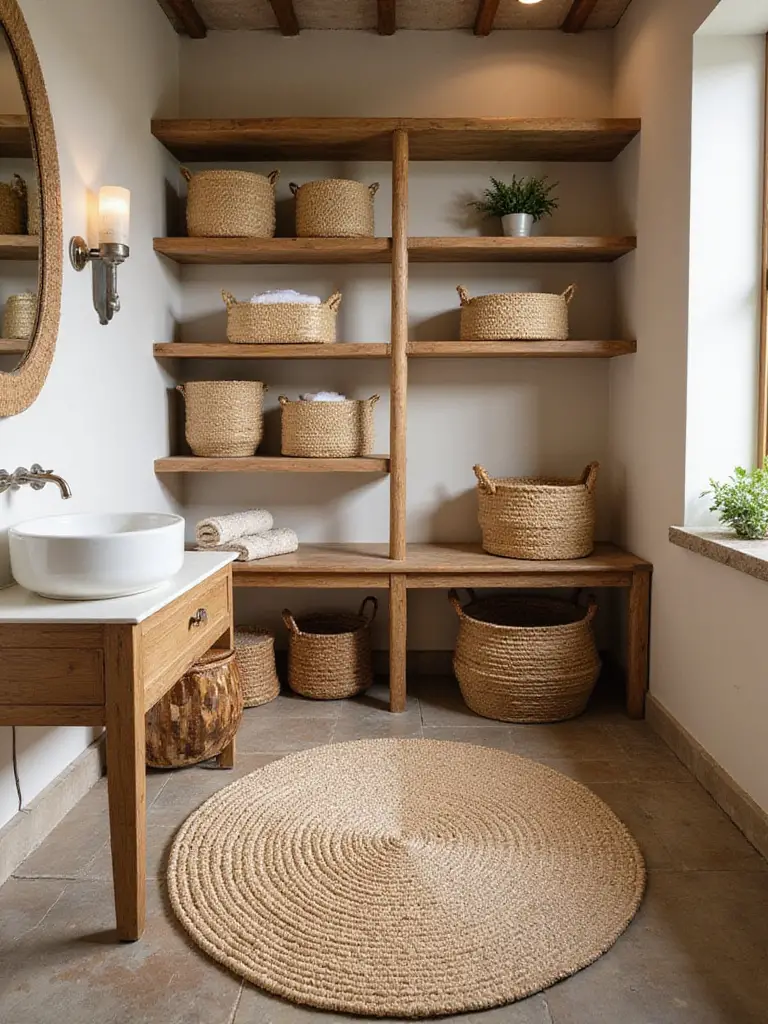
Beyond textiles, bring in baskets. A woven seagrass or palm leaf basket is the perfect place to store rolled-up towels or hide away extra toilet paper. The organic shape and texture provide a necessary counterpoint to the straight lines of tile and cabinetry. A friend was struggling with her bathroom feeling “too hard,” and my only advice was to add a large, soft rug and a big woven basket for her towels. It completely transformed the space from a functional room into a welcoming retreat.
Selecting Core Rustic Bathroom Fixtures
Fixtures are the functional workhorses of the bathroom, but they’re also your biggest opportunity to make a statement. Choose wisely. Each one should feel like a piece of sculpture.
12. Anchor the Room with a “Quietly” Distressed Vanity
A distressed wood vanity is a fantastic anchor piece, but “distressed” doesn’t have to mean beaten up with chains and covered in crackle paint. The most beautiful distressing is the kind that nature provides. Look for a vanity made from a single, beautiful slab of wood where the “imperfections”—the grain, the knots, a live edge—are the main feature. Or opt for a clean, minimalist design made from a sun-bleached wood that feels soft and gentle.
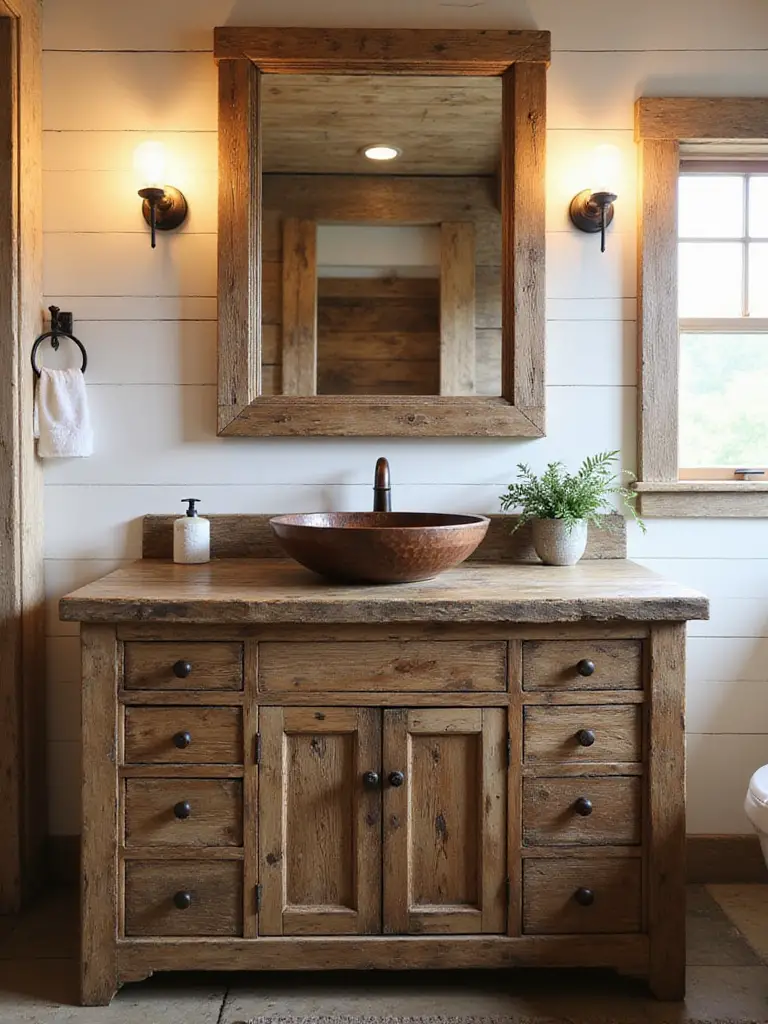
For a true blend of rustic warmth and clean minimalism, I love designing floating vanities. Lifting the cabinet off the floor makes the entire room feel larger and more open, while the natural wood provides the necessary warmth and texture. The goal is to choose a piece that has character but doesn’t scream for attention. It should be a strong, quiet presence that grounds the whole room.
Sitting atop that vanity should be something equally special.
13. Choose a Sink That Feels Like an Object of Art
Ditch the standard, sterile white undermount sink. A vessel sink, which sits on top of the counter, is an opportunity to introduce a truly artisanal element. A sink carved from a single piece of river stone or veined marble immediately becomes a focal point. Its organic shape and unique patterns are a celebration of natural materials.
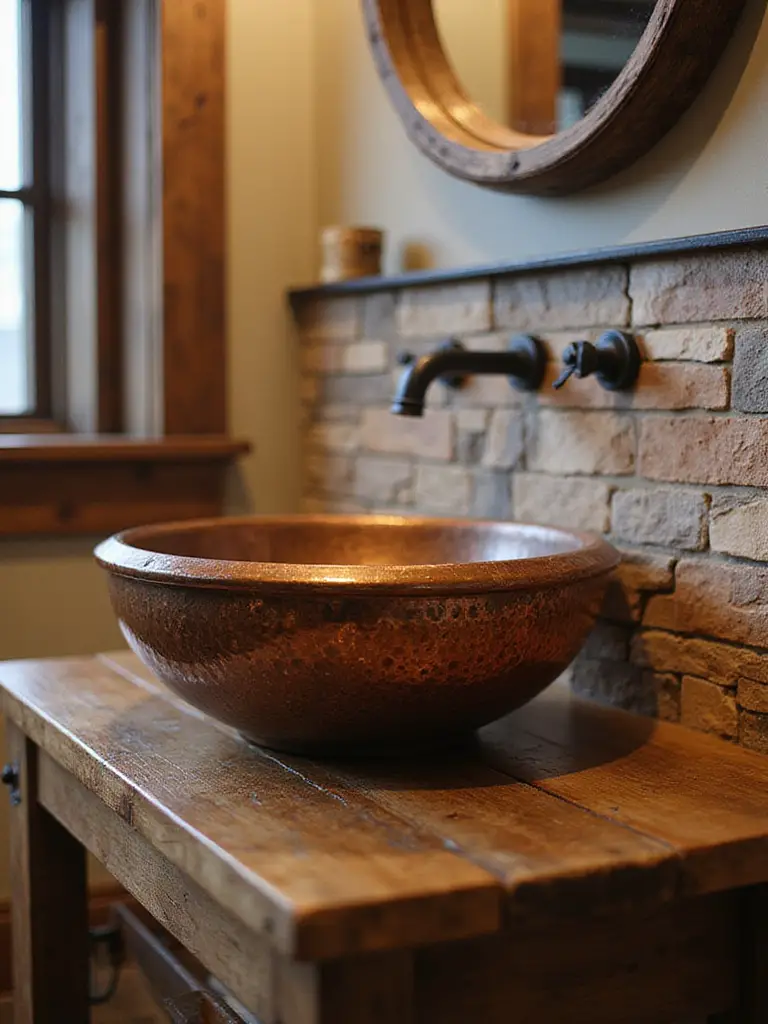
Another stunning option is a hammered metal sink, in either copper or brass. The hand-hammered facets catch the light beautifully, and the living finish will evolve over time. I once used a deep, round brass vessel sink on a floating oak shelf in a tiny powder room. That simple combination had so much character that the room needed almost no other decoration. It’s a shortcut to a high-impact, soulful space.
Next, consider how you enter this beautiful space.
14. Choose a Better Door, Not Just a Barn Door
Barn doors have become a massive farmhouse cliché. While they can save space, their rustic-industrial hardware can feel out of place unless you’re genuinely in a barn. For a more sophisticated and timeless solution, consider a simple, solid wood pocket door. It offers the same space-saving benefits but disappears neatly into the wall, keeping the lines of your room clean and uncluttered.
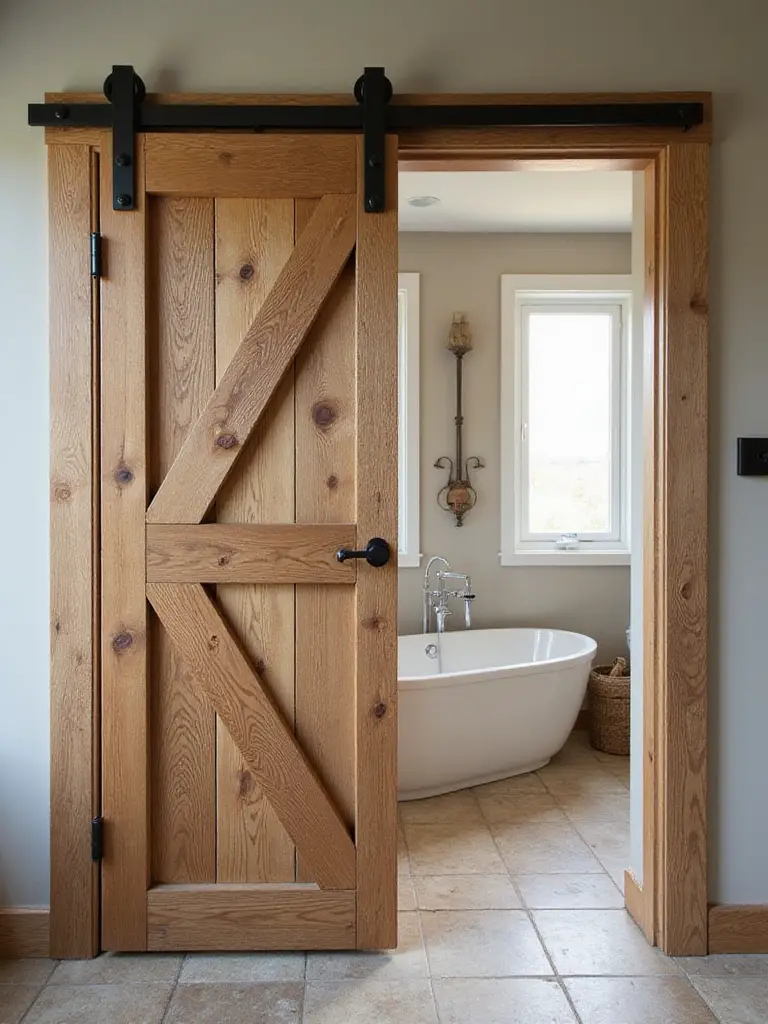
If you want the door to be a feature, a better option is a custom door that reflects the design of the space. I’ve designed slatted wood doors that echo the lines of a reeded vanity, or doors with a simple inset panel of linen or woven cane. These options add texture and interest while feeling much more integrated and intentional than a piece of off-the-shelf hardware. The goal is to solve the functional problem of the door in a way that enhances, rather than dictates, the room’s aesthetic.
Let’s turn our attention to the fixtures that you touch every day.
15. Upgrade Your Faucets to a “Living” Finish
Your faucets are the jewelry of the bathroom. Choosing the right ones can elevate the entire space. As I mentioned before, my top choices are unlacquered brass or matte black. Chrome is too cold and clinical for a truly rustic space. A “living finish” like raw brass tells a story—it registers the oils from your hands, the splashes of water, and slowly develops a patina that is unique to your home. It’s a small detail that makes a profound difference.
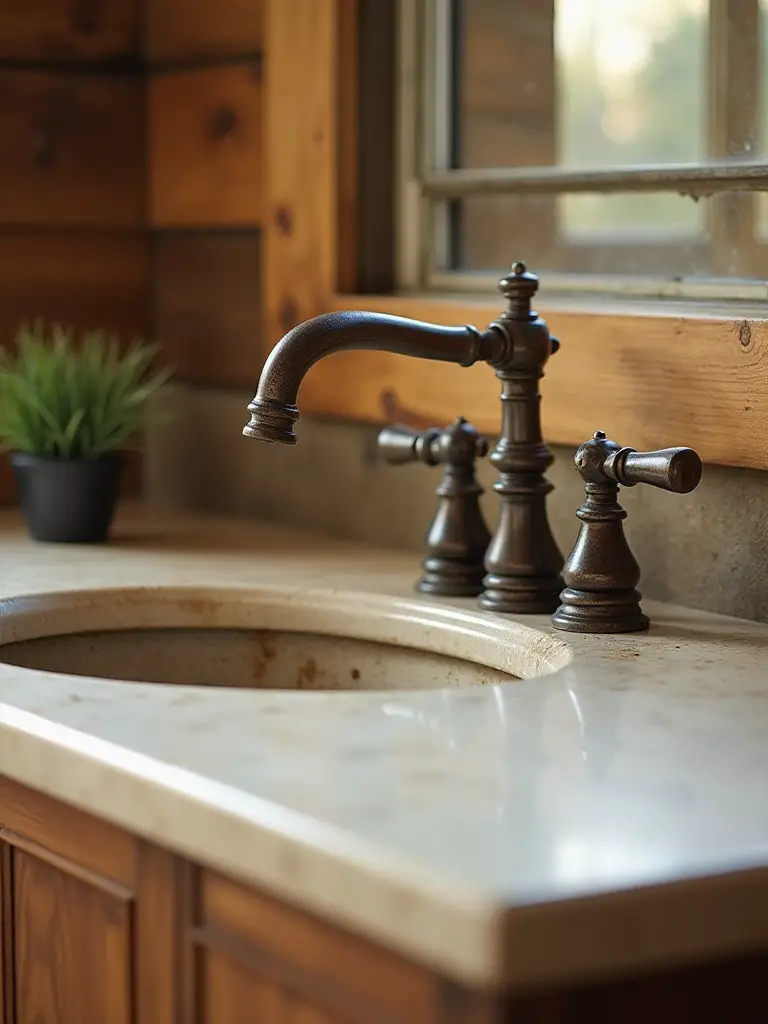
I tell my clients to invest in quality here. You touch your faucets every single day. A well-made, solid brass faucet feels heavy and substantial in your hand. It’s a daily tactile reminder of the quality and thoughtfulness you’ve put into the space. Don’t compromise. It’s a shortcut to making the entire room feel more luxurious and authentic.
Now for the ultimate indulgence, the bathtub.
16. Reconsider the Clawfoot Tub
Here’s a controversial take: the clawfoot tub is not always the right answer. It’s a very specific, Victorian-era look that can feel out of place in a more modern or minimalist rustic space. The real luxury in a rustic bathroom is a bathing experience that feels connected to the materials around you.
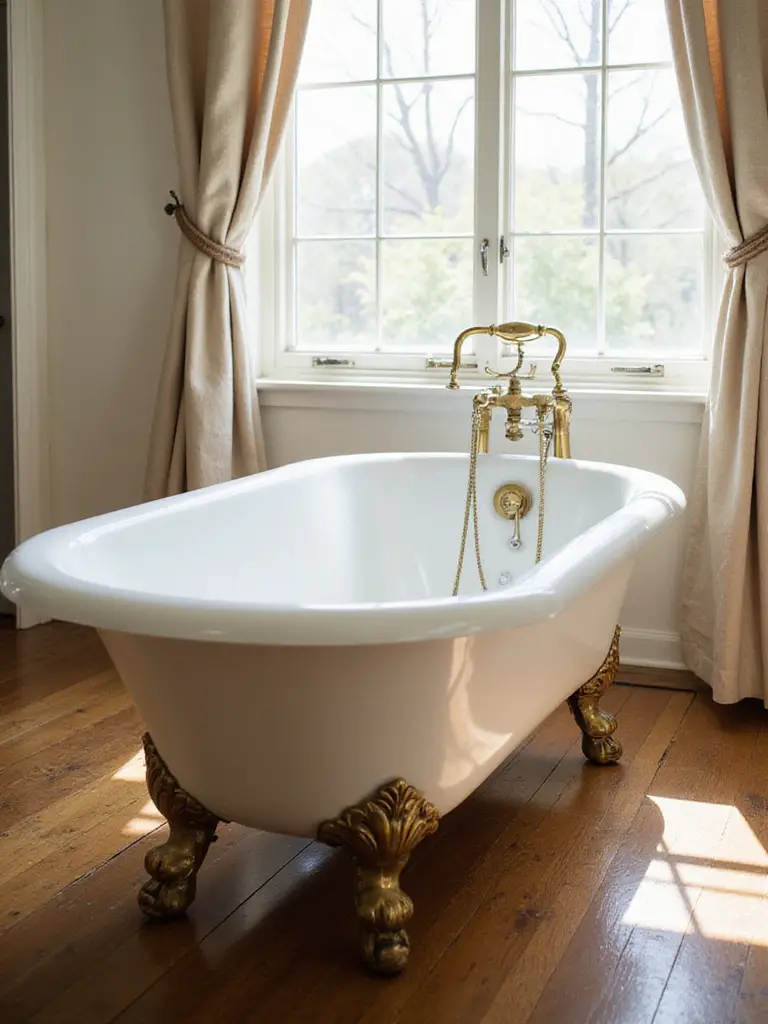
Instead of a clawfoot, consider a simple, sculptural freestanding tub with clean lines. It offers the same dramatic focal point but feels more contemporary. Or, for the ultimate integration of material and function, a built-in tub with a surround made from waterproof plaster (tadelakt) or clad in the same stone as your floor. This creates a grotto-like feeling, as if the tub was carved right out of the room. It’s an approach rooted in the ancient traditions of bathhouses, and it feels infinitely more grounded and serene.
To showcase these beautiful fixtures, you’ll need smart storage.
17. Use Open Shelving Like a Museum Curator
Open shelving is perfect for a rustic bathroom, but it’s not a license to display all your clutter. The trick is to be a ruthless editor. You’re not just storing things; you’re creating a composition. I prefer a single, thick, floating shelf made of the same wood as the vanity, or a niche carved directly into a plaster wall.
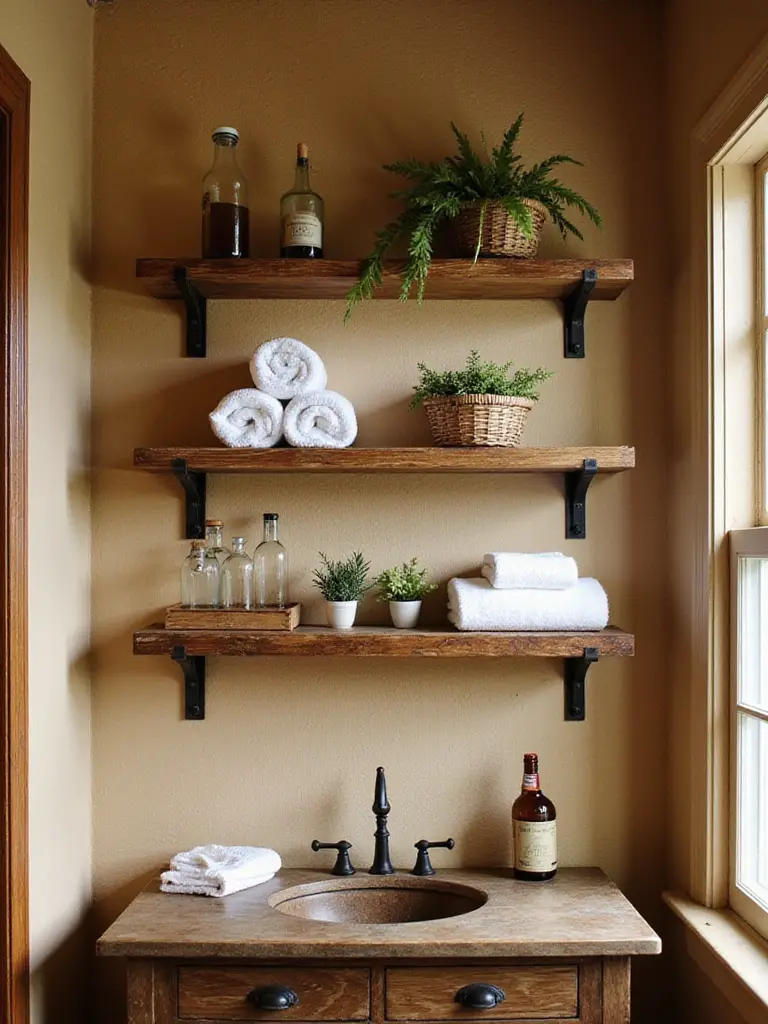
Use these shelves for the essentials that are also beautiful: neatly rolled linen towels, a ceramic cup for toothbrushes, a beautiful bottle of soap, a small plant in an earthenware pot. Everything else—the plastic bottles, the extra toothpaste, the cleaning supplies—should be hidden away behind a closed door. This balance of open and closed storage is the key to a space that feels lived-in and personal, but also calm and uncluttered.
Enhancing Rustic Charm with Thoughtful Accents
The big pieces are in place. Now it’s time for the final, intimate layer—the details that bring the room to life.
18. Illuminate with a Soft, Sculptural Glow
Good lighting is everything. Instead of a generic bar light above the mirror, opt for a pair of sconces on either side. This provides cross-illumination that’s far more flattering and shadow-free. But don’t just grab a forged iron sconce and call it rustic. Think about the quality of the light you want.
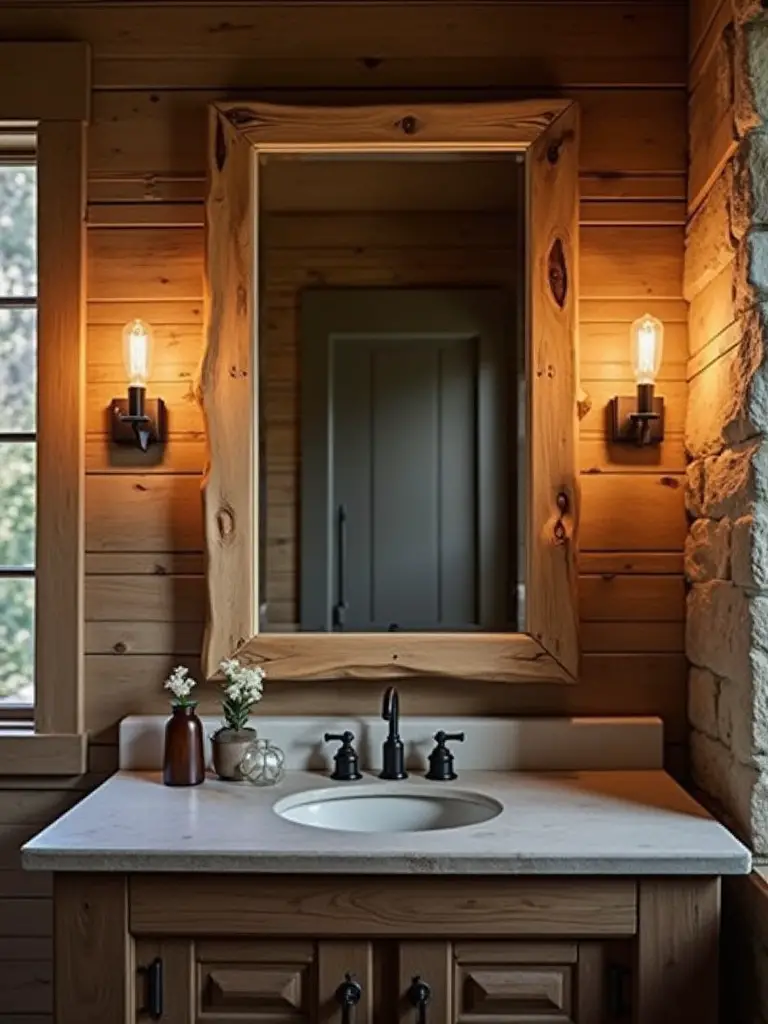
I love using sconces made of materials that diffuse light beautifully, like alabaster, ceramic, or even plaster. They cast a soft, warm glow that makes the whole room feel serene. Position them at eye level, around 60-65 inches from the floor, and always, always put them on a dimmer switch. This is the single best and cheapest upgrade you can make to a bathroom. It allows you to have bright, functional light when you need it, and a low, candle-like glow when you want to relax in the bath.
With the lighting set, bring in more layers of texture and order.
19. Organize with Woven Baskets and Trays
This is my secret weapon for making any space feel instantly warmer and more organized. A simple woven basket is the perfect textural counterpoint to the hard surfaces of a bathroom. Use a large one on the floor for laundry or rolled-up bath towels. Use smaller ones on a shelf to wrangle loose items like lotions and soaps. They add an organic, handmade element that is the essence of rustic style.
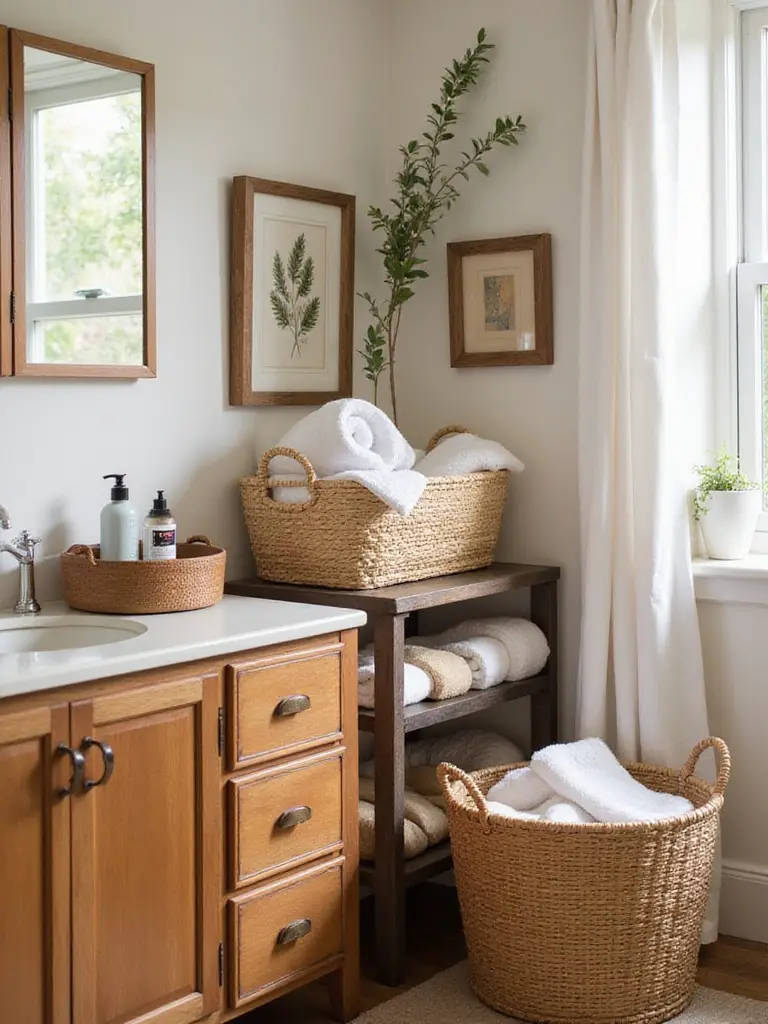
On the countertop, use a simple wooden or slate tray. It’s a designer trick for making a collection of necessary items—a soap dispenser, a cup, a small dish—look intentional and curated instead of cluttered. Grouping them on a tray creates a visual anchor and instantly makes the surface feel tidier. It’s a tiny change that has a huge impact on the calm feeling of the room.
Now, add one final layer of indulgent comfort.
20. Lay Down a Layer of Unexpected Luxury
The feeling of stepping out of a warm bath onto a cold, hard floor is jarring. A bath mat is a necessity, but it can also be a moment of pure indulgence. Instead of a standard terry cloth mat, consider something with more texture and personality. A chunky, hand-knitted wool mat or a plush, genuine sheepskin rug adds a layer of deep comfort and softness. It’s a classic Scandinavian touch that speaks to the “hygge” desire for coziness.
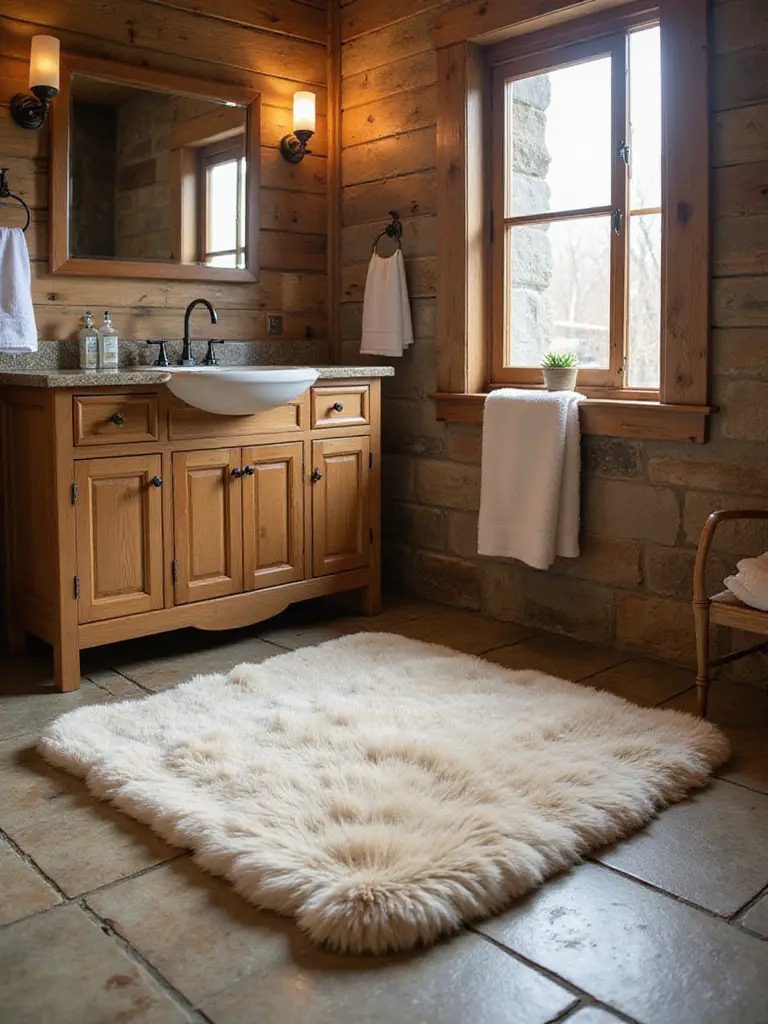
The contrast between the soft, deep pile of a wool rug and the cool smoothness of a stone floor is incredible. It’s another one of those sensory details that elevates the entire experience of being in the room. Just make sure you can air it out properly. This is one of those moments where a little extra care is worth the immense payoff in daily comfort.
Now let’s bring in a few pieces with a past.
21. Display Vintage Finds That Have Soul
A truly rustic space should feel like it has been collected over time, not installed in a weekend. This is where vintage pieces come in. But be selective. You’re not creating an antique shop. You’re looking for a few special items with a soul that complement your clean, modern foundation. It could be a small, weathered wooden stool next to the bathtub to hold a book and a cup of tea. It might be an old, silver-backed mirror with just a bit of elegant patina.
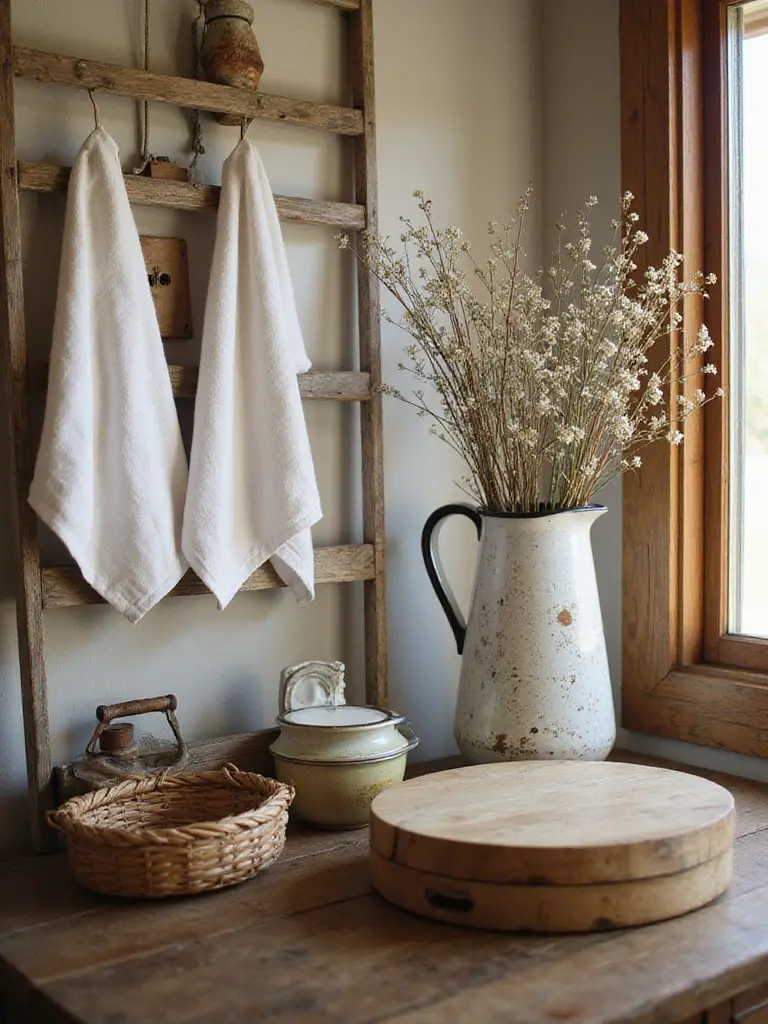
One of my favorite finds for a client was a set of old, beautifully crazed ceramic canisters. We used them to hold cotton balls and bath salts. They were functional, but their history added a layer of personality that you could never buy new. The key is to look for pieces with simple forms and honest wear. These are the items that keep a modern rustic space from feeling sterile and give it its unique, irreplaceable character.
Smart Rustic Solutions & Details
Finally, a few clever hacks that deliver maximum rustic charm with minimal effort. These are the little details that show personality and resourcefulness.
22. Repurpose an Old Ladder for Sculptural Storage
This is one rustic “trope” that I actually love, because it’s so beautifully simple and functional. A simple wooden ladder—especially a slender, primitive one or a modern bamboo version—is the perfect place to hang towels. It uses vertical space efficiently, allows towels to air dry properly, and acts as a graphic, sculptural element against a plain wall.
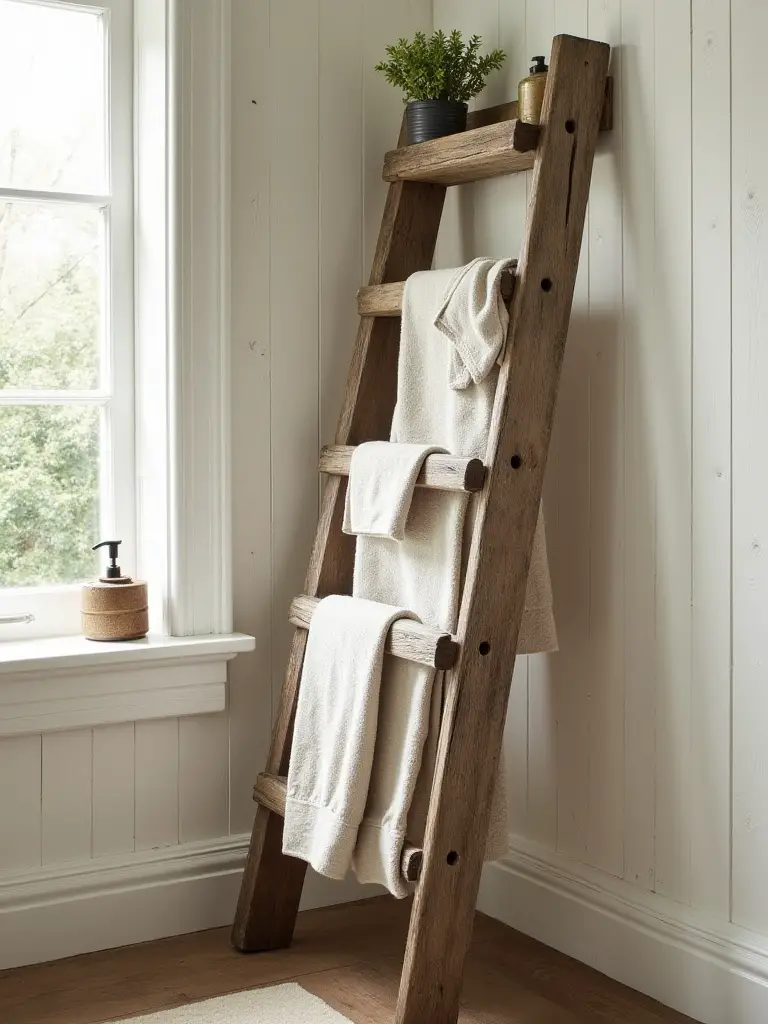
The key is to keep it simple. Don’t clutter it up with a dozen hanging doodads. Just a few, beautiful linen towels draped over the rungs is all you need. It’s functional art. For extra stability, especially if you have kids, use a small L-bracket to discreetly secure the top to the wall. It’s a solution that is both incredibly stylish and incredibly practical.
To finish, here’s a DIY that is simple, cheap, and perfectly on-brand.
23. Elevate Your Countertop Jars
Everyone suggests Mason jars for rustic storage, but they can feel a bit predictable. Let’s elevate the idea. The principle—using simple glass or ceramic vessels for storage—is excellent. But instead of a matched set of canning jars, create a more “collected” look. Go to a thrift store and find a few mismatched glass jars in interesting shapes. Or use simple, unglazed earthenware cups or bowls.
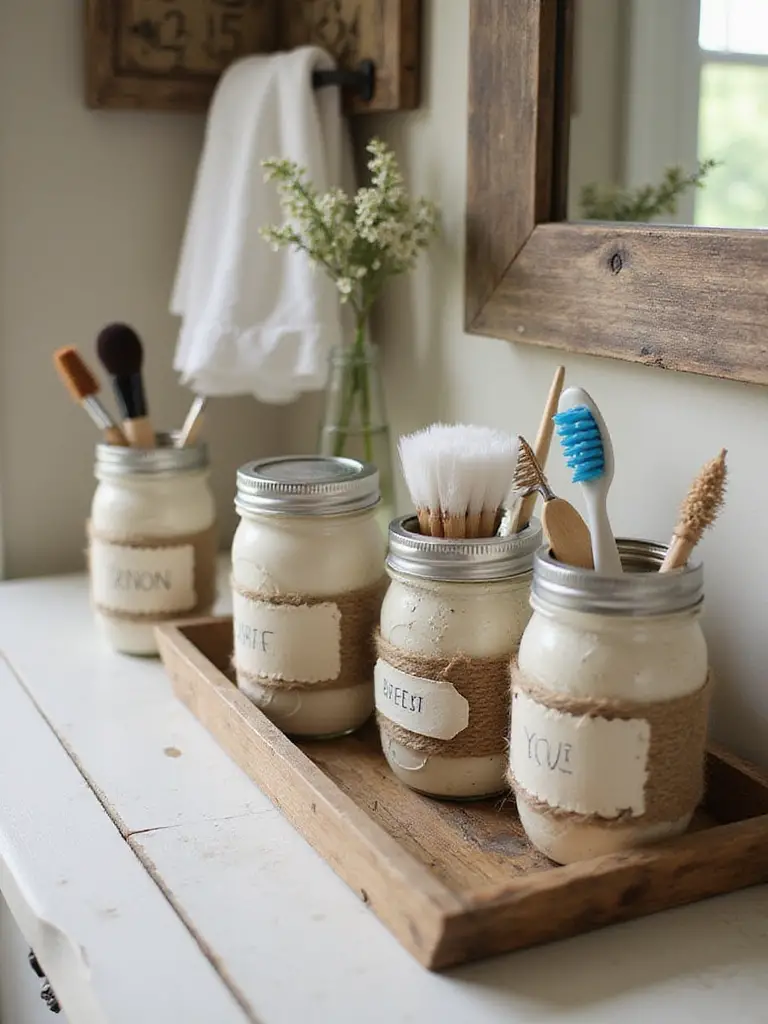
I love using a collection of small ceramic vessels in varying heights to hold things like cotton swabs, makeup brushes, and toothbrushes. They look beautiful grouped together on a simple tray. It’s about taking an everyday need—organization—and finding a solution that is not just functional, but also adds a layer of curated, handmade beauty to your countertop.
Your Rustic Sanctuary
Creating a rustic bathroom isn’t about following a checklist of items. It’s a design philosophy. It’s about stripping away the non-essential to reveal the inherent beauty in honest materials. It’s about creating a conversation between the clean and the textured, the modern and the ancient, the warm and the cool.
When you focus on the quality of light, the feel of materials, and the story of the objects you bring into your home, you create more than just a beautiful room. You create a sanctuary. A space that grounds you, calms you, and connects you back to something real. It’s your retreat from the world, and it should feel, above all, like you.
